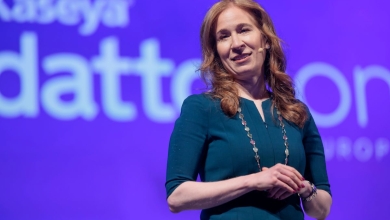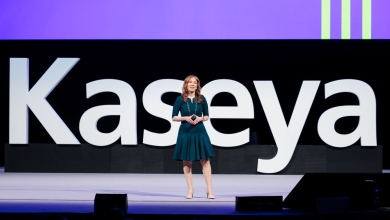
As technology, compliance, and security pressures intensify, many managed service providers (MSPs) are finding that competitive advantage no longer comes from going it alone. Instead, cross-partner collaboration—between peers, across regions, and sometimes across borders—is emerging as a strategic lifeline.
“Every single week, I’m probably doing 12 intros to partners around the world,” said Greg Jones, Senior Vice President of MSP Enablement at Kaseya (pictured left). “And that could be someone in the Netherlands asking for a partner in Germany. It could be someone in Philadelphia looking for someone in the UK. It is happening en masse.”
Jones says the driver is straightforward: client demand now often exceeds what any single MSP can deliver alone. “We’re seeing a lot of co-managed IT now. It’s very rare that an MSP does everything anymore. And especially with the market being so broad, it’s about having the right partner, that you can trust, that you can rely on, that delivers that part of the stack that you need.”
That need is made more acute by ongoing challenges in recruitment. “You know, the skills gap is still very real,” Jones added. “Cybersecurity, compliance as a service, AI—there’s a shortage of talent across the board. If you can't hire, you have to find another way to deliver. And that’s where these peer relationships come in.”
Partnering with Purpose
Ian Dunstan, CEO of UK-based MSP Cobalt (pictured middle), echoes the sentiment—although he prefers a different framing. “I use the word partnership rather than peering because I think peering, as a word, is a bit overused and undervalued,” he explained. “There’s a real difference between a referral partner and a collaborative partner.”
Dunstan recounts a story about helping another MSP—Bluegrass—launch an entirely new line of business. “We put all of our services into a brochure, rebranded as Bluegrass Cloud, and handed it to them. They didn’t know how to do comms. We did. They took it to their customers, sold it under their name. We billed them. They billed the customer.”
This wasn’t charity. It was strategy. “They were being squeezed by another vendor, and if they didn’t do something, they would have lost that business. I didn’t want a finder's fee. I didn’t want a revenue share. I wanted them to be in the game because we’re stronger together.”
Economics of Scale and Skills
For both leaders, the financial rationale for partnership is compelling—especially when it comes to big-ticket investments like Security Operations Centres (SOC) or Network Operations Centres (NOC).
“You’re not going to spin up your own SOC just for one client,” said Jones. “It’s hugely expensive—staffing 24/7, tooling, compliance. But if you can partner with someone who already has that capability, you can still offer the service. You stay relevant and profitable without the upfront cost.”
Jones notes that Kaseya is seeing this play out across its partner base. “We’re seeing compliance-as-a-service now as a hot topic. NIS2, GDPR, HIPAA—you need expertise to do it well. If you don’t have it, partner. There’s no shame in it.”
Kevin Lockhart, CEO of Couno (Pictured right), adds a practical dimension to the economics. “The tooling is expensive. And if you don’t have the capability internally, you’re going to look at partnerships. It just makes sense. We’re not trying to be the masters of everything.” He explains that while clients expect breadth of service, it's often unrealistic to deliver everything in-house. “We’re seeing demand now for things like AI transformation, cyber, DLP… you need experts. And those experts are expensive and hard to find.”
Cross-Border Opportunity
While collaboration often starts regionally, its potential is increasingly global. “We’re seeing international partnerships happening all the time,” said Jones. “I’ve done intros between a UK partner and one in Amsterdam who now share clients. They started out wanting a backup engineer. They now run shared services across three countries.”
Lockhart’s experience supports this. “A lot of our clients are international. We’ve had to think that way because of Brexit. We now have operations in Amsterdam—it opened up a new market, but we’re also reliant on partners in places we don’t cover directly.”
Dunstan says that for MSPs confident in their core capabilities, expanding via partnership can be low-risk and high-reward. “We’re really good at infrastructure and networking. We’ve done that 30 times. If someone’s good at voice or pen testing, we’ll partner. And in return, they might pick up our hosting. It’s reciprocal.”
The Human Factor
But not every partnership succeeds. “The number one reason these things fail is that people don’t put enough time into it,” Dunstan warned. “It’s like a marriage. Everyone remembers the wedding day. But after that, it takes work. It takes communication. You’ve got to have goals.”
He also cautioned that maturity matters. “You can’t partner with someone who’s not ready. If they’re still trying to work out their support queue, they’re not going to deliver at the standard your customers expect.”
Both Jones and Dunstan agree that alignment—on values, quality standards, and customer experience—is more important than geography or even size.
“If you’re scared of sharing customers or worried someone’s going to poach your business,” Dunstan said, “maybe that says more about your business than theirs. We’ve done 30 partnerships over the last 10 years. I could count on one hand the ones that didn’t work—and they failed because someone didn’t put in the time.”
The Future Is Ecosystems
As the MSP model evolves, so too does the nature of the channel. What was once a competitive race to lock in services is now a networked ecosystem of shared capabilities and aligned interests.
“You can’t be all things to all people,” said Jones. “But if you know what you’re good at—and you find the right partner—you can deliver a better outcome than anyone else.”
Lockhart makes a similar point: “The stack debate—best of breed versus single vendor—is missing the point. It’s about outcomes. If the customer’s protected and supported, how you get there matters less than the fact you do.”
It’s a view increasingly backed by data. According to CompTIA’s 2024 “State of the Channel” report, 72% of MSPs say they are exploring or already engaged in strategic peer alliances, up from just 48% in 2022. The primary driver? The need to scale capabilities without scaling headcount or overhead.
Dunstan’s advice to others is simple: “Go to events. Talk to people. Tell them what you’re trying to do. Don’t be afraid to ask for help—you’ll be surprised how many want to help you back.”
In a market where complexity is the norm, not the exception, peer collaboration isn’t just a nice idea—it’s fast becoming a business imperative.


